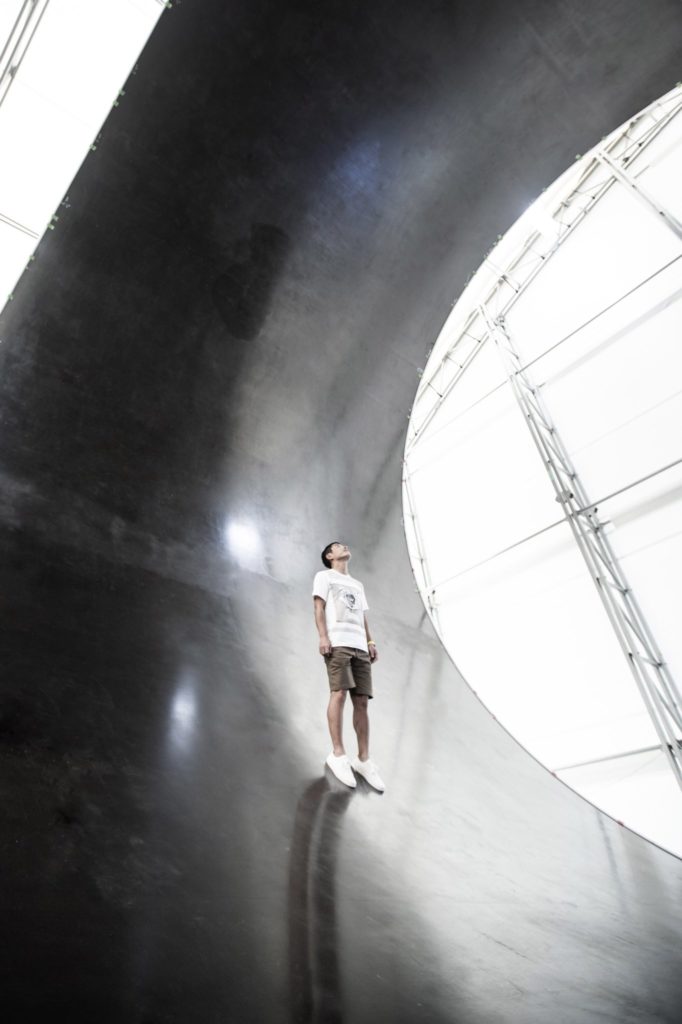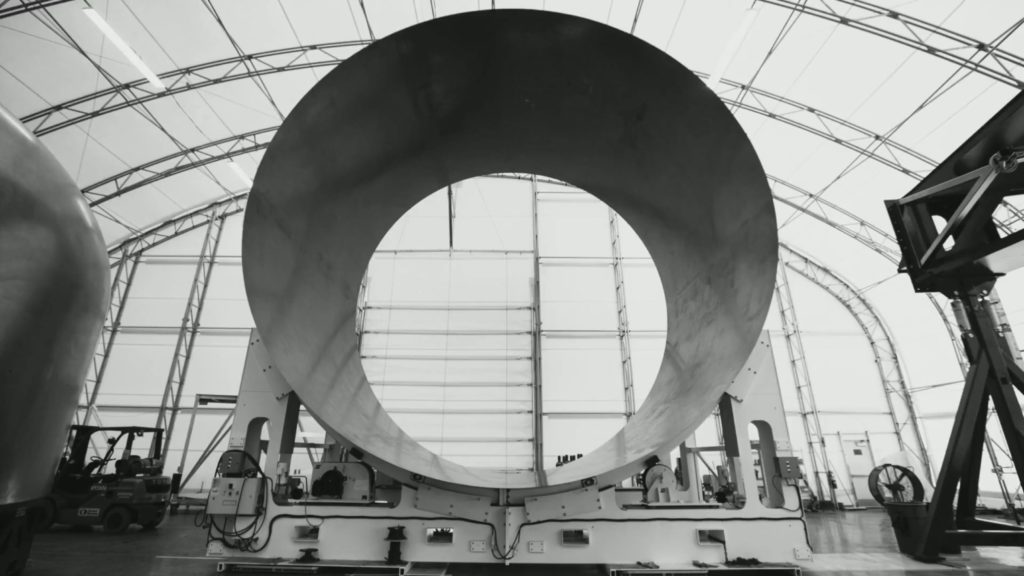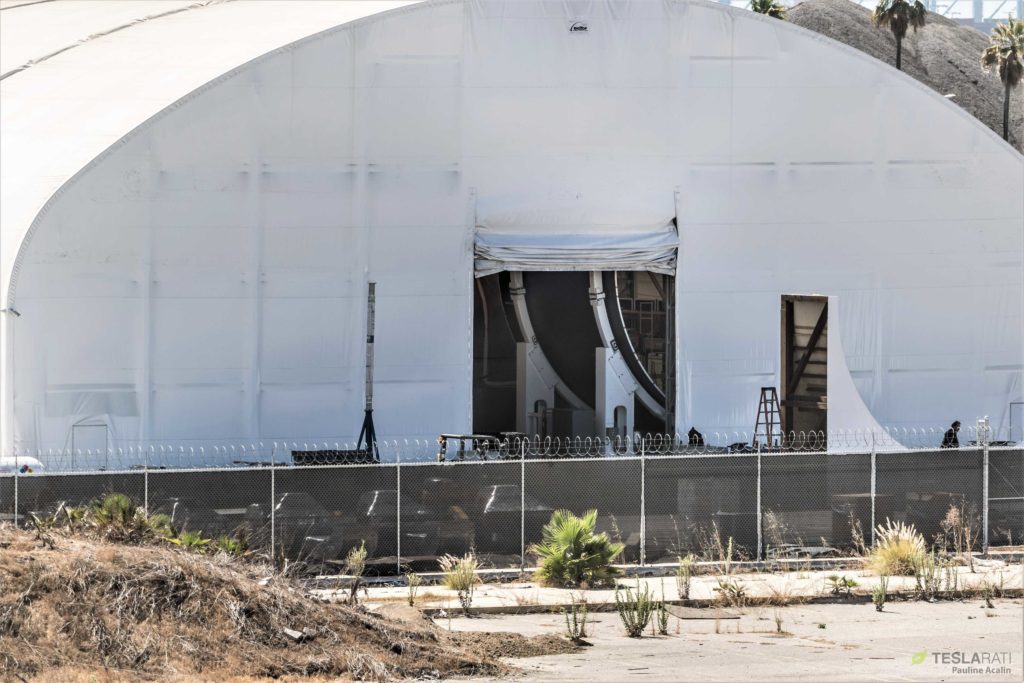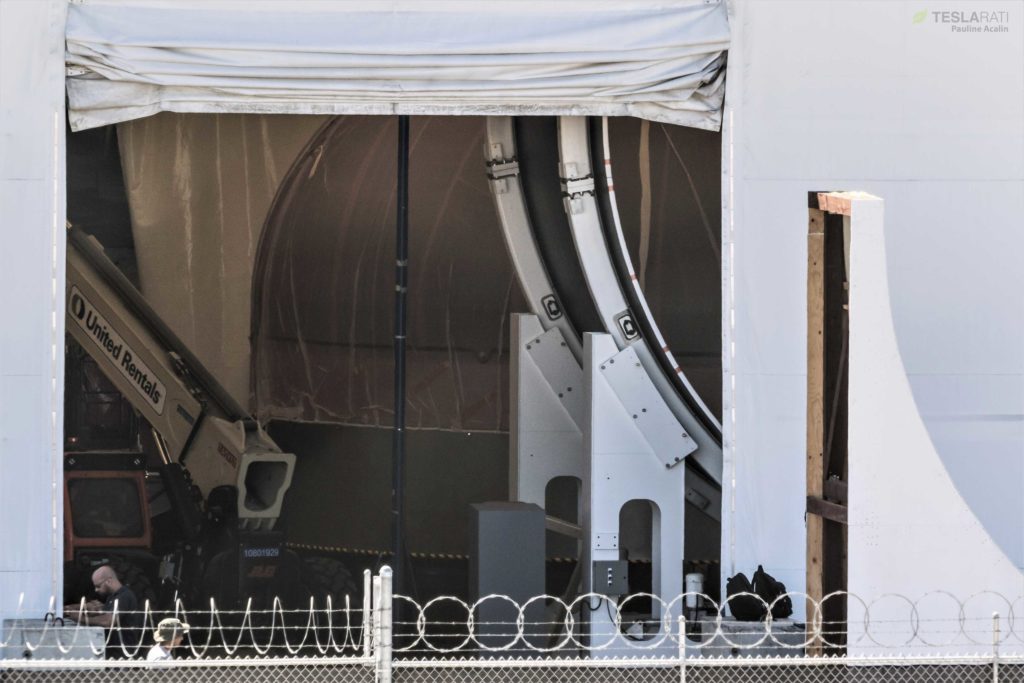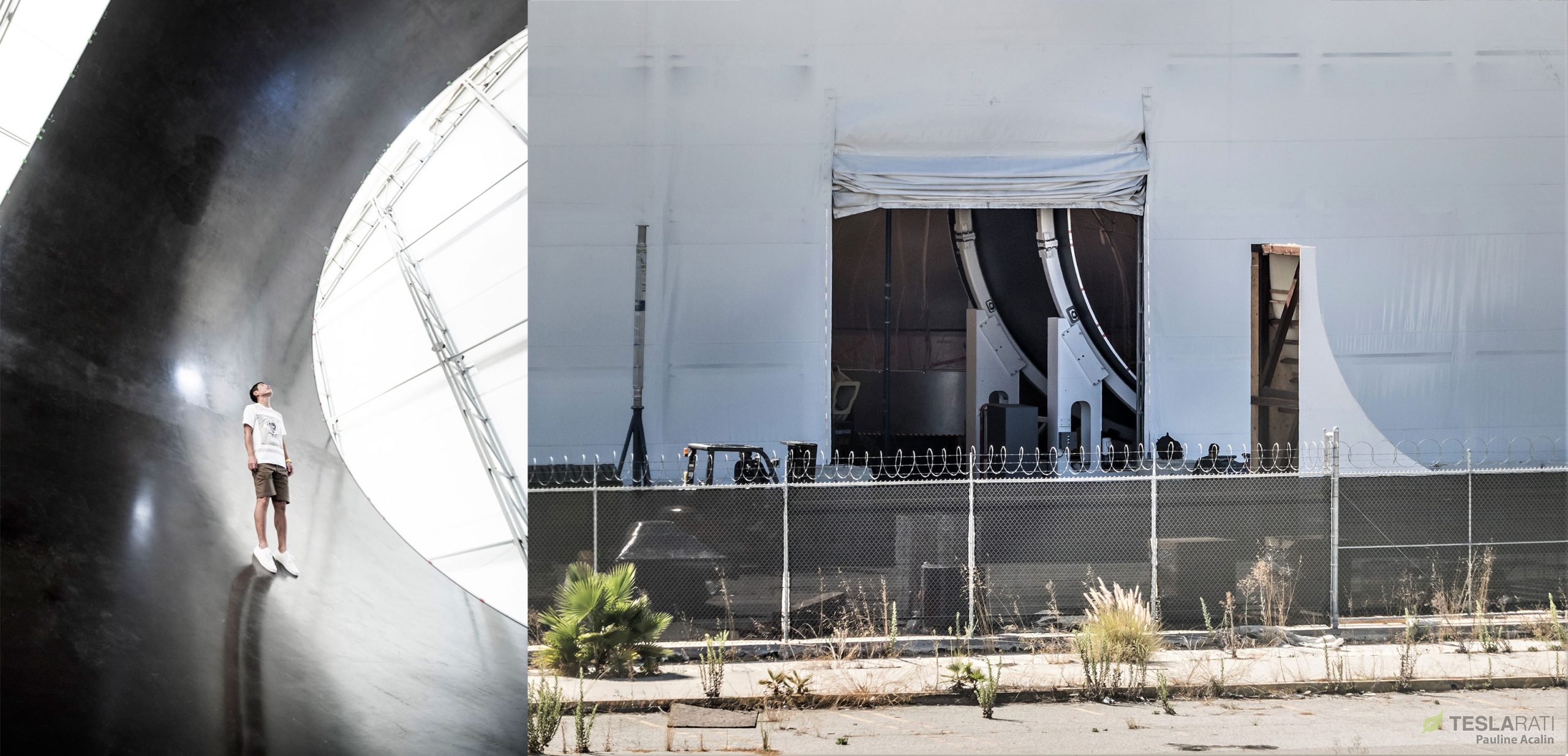
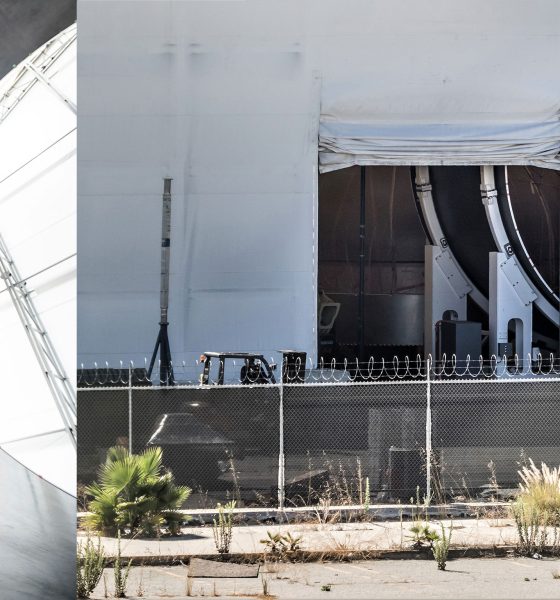
News
SpaceX’s first completed BFR spaceship section spotted in huge Port of L.A. tent
Described by CEO Elon Musk as “the first [completed] cylinder section” of SpaceX’s first BFR spaceship prototype, Teslarati’s West Coast photographer spotted the massive 9 meter (~30 foot) diameter carbon composite structure – looking exactly as it appeared in photos SpaceX provided during the Sept. 17 reveal – inside the company’s dedicated BFR fabrication tent.
That’s the first BFR airframe/tank barrel section made of a new carbon fiber material
— Elon Musk (@elonmusk) September 18, 2018
Located at the Port of Los Angeles, SpaceX erected a huge, temporary tent at a leased berth in December 2017, choosing to begin fabrication of the first BFR composite structures in a more impromptu manner rather than waiting for the completion of lengthy regulatory processes and many more months of construction of a dedicated Mars rocket factory, also to be sited at Port of LA. Both the factory and temporary facility were located in a port (rather than at SpaceX’s already-established Hawthorne factory) due to the simple impracticality of transporting 9m-diameter parts through downtown Los Angeles, estimated to cost a minimum of several million dollars one way from a spattering of past transport projects.
Nine months after the structure was little more than a metal skeleton, SpaceX’s tented facility is now a mature in situ manufacturing wing of the company, evidenced by the fact that SpaceX has already completed its first full-scale composite section (both a section of the spaceship’s fuselage and one of its propellant tanks) and is pushing ahead into full builds of composite tank domes and the spaceship prototype’s Raptor engine section. It may not be practical as a long-term solution, and that certainly is not the plan, but SpaceX seems to be having very little difficulty growing into the eccentric aerospace composites manufacturing hub.
- Yusaku Maezawa stands on the first BFR composite tank/fuselage section prior to his Sept. 17 announcement. (Yusaku Maezawa)
- SpaceX has already completed the first of many carbon-composite sections of its prototype spaceship. (SpaceX)
- SpaceX’s BFR composites tent had a flap open on September 18th, showing off the very same tank section revealed in a presentation by CEO Elon Musk the day before. (Pauline Acalin)
- Inside the BFR tent, another tent. Never too many tents. (Pauline Acalin)
Judging from photos of the fresh composite tank section peeking its head out of the tent flap, the question of “How does SpaceX move this outside?” becomes rather unavoidable, and it seems that the plan is to fabricate and assemble the vast majority of the prototype spaceship’s monolithic composite structures before quite literally cutting out a section or partially disassembling the tent.
Thankfully, the dedicated BFR factory SpaceX is now in the process of building happens to be just a few miles away from the tent that manufacturing work is currently housed in, and that should make for relatively easy barge transport to said factory once its first phase of construction is complete (as early as Q2-Q4 2019). As of September 1st, the future location of that factory is currently going through gradual phases of site preparation, most notably including the installation of below-ground utilities and general surveying, dirt-moving, and leveling of the actual ground the factory will be built on.
As of 9/1… pic.twitter.com/r2nF9CgdAc
— Pauline Acalin (@w00ki33) September 18, 2018
Perhaps as early as H2 2019, SpaceX will begin to move its first complete or partially-complete BFR spaceship prototype from its tented production facility to the Southern Coast of Texas, where it will begin a series of hot-fire hop tests to prove out its Raptor engines, aerodynamic characteristics, structural composition, and more.
For prompt updates, on-the-ground perspectives, and unique glimpses of SpaceX’s rocket recovery fleet check out our brand new LaunchPad and LandingZone newsletters!

News
SpaceX reportedly mulling IPO, eyeing largest of all time: report
“I do want to try to figure out some way for Tesla shareholders to participate in SpaceX. I’ve been giving a lot of thought to how to give people access to SpaceX stock,” Musk said.

SpaceX is reportedly mulling an initial public offering, eyeing what would be the largest valuation at the time of availability of all time, a new report from Bloomberg said on Tuesday.
It is one of many reports involving one of Elon Musk’s companies and a massive market move, as this is not the first time we have seen reports of an IPO by SpaceX. Musk himself has also dispelled other reports in the past of a similar nature, including an xAI funding round.
SpaceX and Musk have yet to comment on the report. In the past, untrue reports were promptly replied to by the CEO; this has not yet gained any response, which is a good sign in terms of credibility.
Musk has discussed a potential IPO for SpaceX in recent months, as the November 6 shareholder meeting, as he commented on the “downsides” of having a public company, like litigation exposure, quarterly reporting pressures, and other inconveniences.
Nevertheless, Musk has also said he wants there to be a way for Tesla shareholders to get in on the action. At the meeting in early November, he said:
“I do want to try to figure out some way for Tesla shareholders to participate in SpaceX. I’ve been giving a lot of thought to how to give people access to SpaceX stock.”
Additionally, he added:
“Maybe at some point., SpaceX should become a public company despite all the downsides of being public.”
Musk has been historically reluctant to take SpaceX public, at times stating it could become a barrier to colonizing Mars. That does not mean it will not happen.
Bloomberg’s report cites multiple unidentified sources who are familiar with the matter. They indicate to the publication that SpaceX wants to go public in mid-to-late 2026, and it wants to raise $30 billion at a valuation of around $1.5 trillion.
This is not the first time SpaceX has discussed an IPO; we reported on it nine years ago. We hope it is true, as the community has spoken for a long time about having access to SpaceX stock. Legendary investor Ron Baron is one of the lucky few to be a SpaceX investor, and said it, along with Tesla, is a “lifetime investment.”
Tesla bull Ron Baron reveals $100M SpaceX investment, sees 3-5x return on TSLA
The primary driver of SpaceX’s value is Starlink, the company’s satellite internet service. Starlink contributes 60-70 percent of SpaceX’s revenue, meaning it is the primary value engine. Launch services, like Falcon 9 contracts, and the development of Starship, also play supporting roles.
News
SpaceX reaches incredible milestone with Starlink program

SpaceX reached an incredible milestone with its Starlink program with a launch last night, as the 3,000th satellite of the year was launched into low Earth orbit.
On Monday, SpaceX also achieved its 32nd flight with a single Falcon 9 rocket from NASA’s Kennedy Space Center.
The mission was Starlink 6-92, and it utilized the Falcon 9 B1067 for the 32nd time this year, the most-used Falcon booster. The flight delivered SpaceX’s 3000th Starlink satellite of the year, a massive achievement.
There were 29 Starlink satellites launched and deployed into LEO during this particular mission:
Falcon 9 launches 29 @Starlink satellites from Florida pic.twitter.com/utKrXjHzPN
— SpaceX (@SpaceX) December 9, 2025
SpaceX has a current goal of certifying its Falcon boosters for 40 missions apiece, according to Spaceflight Now.
The flight was the 350th orbital launch from the nearby SLC-40, and the 3,000 satellites that have been successfully launched this year continue to contribute to the company’s goal of having 12,000 satellites contributing to global internet coverage.
There are over five million users of Starlink, the latest data shows.
Following the launch and stage separation, the Falcon 9 booster completed its mission with a perfect landing on the ‘Just Read the Instructions’ droneship.
The mission was the 575th overall Falcon 9 launch, highlighting SpaceX’s operational tempo, which continues to be accelerated. The company averages two missions per week, and underscores CEO Elon Musk’s vision of a multi-planetary future, where reliable connectivity is crucial for remote work, education, and emergency response.
As Starlink expands and works toward that elusive and crucial 12,000 satellite goal, missions like 6-92 pave the way for innovations in telecommunications and enable more internet access to people across the globe.
With regulatory approvals in over 100 countries and millions of current subscribers, SpaceX continues to democratize space, proving that reusability is not just feasible, but it’s also revolutionary.
News
Tesla expands new Full Self-Driving program in Europe
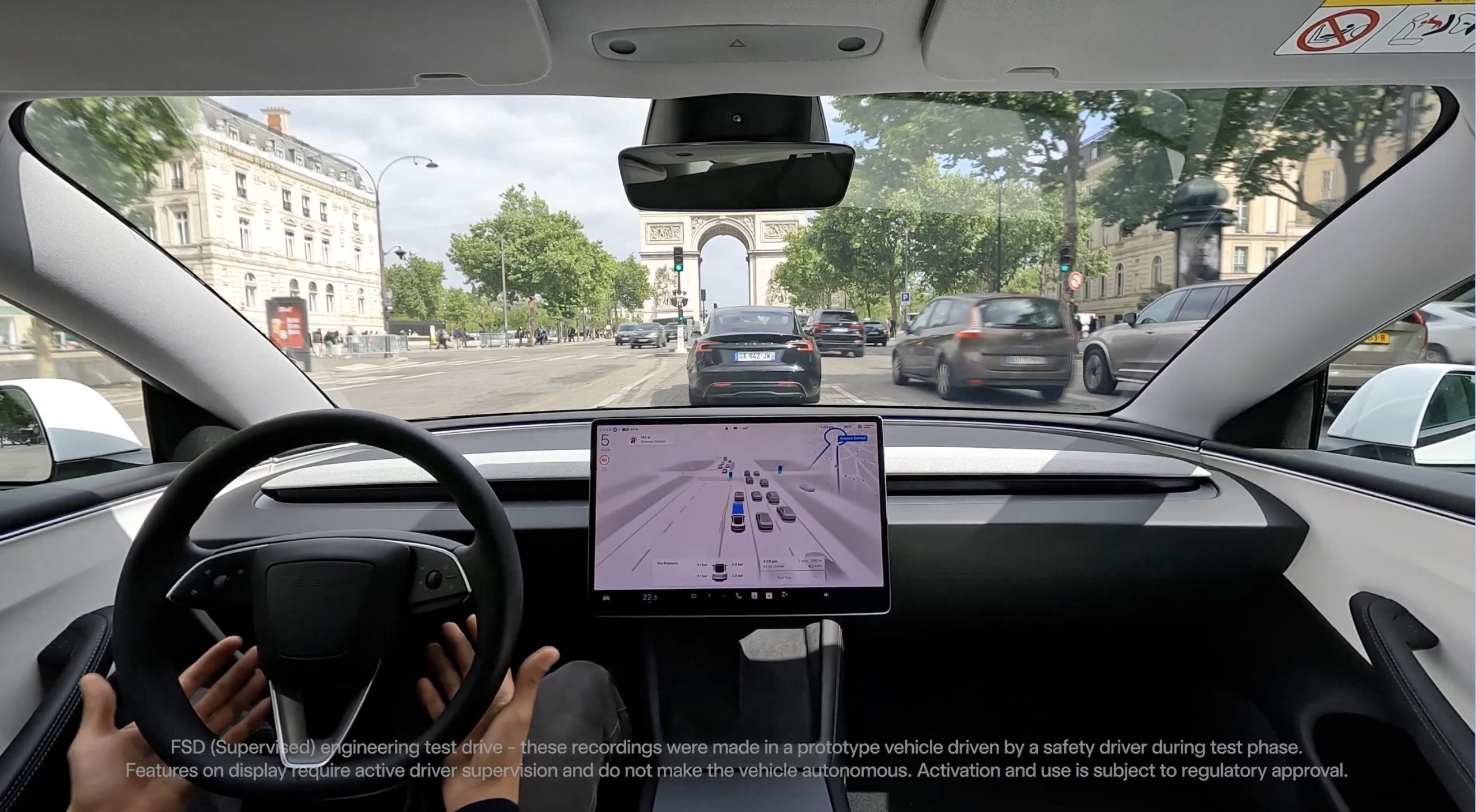
Tesla expanded its new Full Self-Driving program, which gives people the opportunity to experience the company’s suite, in Europe.
Tesla recently launched an opportunity for Europeans to experience Full Self-Driving, not in their personal vehicles, but through a new ride-along program that initially launched in Italy, France, and Germany back in late November.
People could experience it by booking a reservation with a local Tesla showroom, but timeslots quickly filled up, making it difficult to keep up with demand. Tesla expanded the program and offered some additional times, but it also had its sights set on getting the program out to new markets.
It finally achieved that on December 9, as it launched rides in Denmark and Switzerland, adding the fourth and fifth countries to the program.
Tesla confirmed the arrival of the program to Denmark and Switzerland on X:
Now available in Denmark & Switzerland
🇩🇰 https://t.co/IpCSwHO566 https://t.co/V2N5EarLNX
— Tesla Europe & Middle East (@teslaeurope) December 9, 2025
The program, while a major contributor to Tesla’s butts in seats strategy, is truly another way for the company to leverage its fans in an effort to work through the regulatory hurdles it is facing in Europe.
Tesla has faced significant red tape in the region, and although it has tested the FSD suite and been able to launch this ride-along program, it is still having some tremendous issues convincing regulatory agencies to allow it to give it to customers.
CEO Elon Musk has worked with regulators, but admitted the process has been “insanely painful.”
The most recent development with FSD and its potential use in Europe dealt with the Dutch approval authority, known as the RDW.
Tesla says Europe could finally get FSD in 2026, and Dutch regulator RDW is key
Tesla said it believes some regulations are “outdated and rules-based,” which makes the suite ineligible for use in the European jurisdiction.
The RDW is working with Tesla to gain approval sometime early next year, but there are no guarantees. However, Tesla’s angle with the ride-along program seems to be that if it can push consumers to experience it and have a positive time, it should be easier for it to gain its footing across Europe with regulatory agencies.
